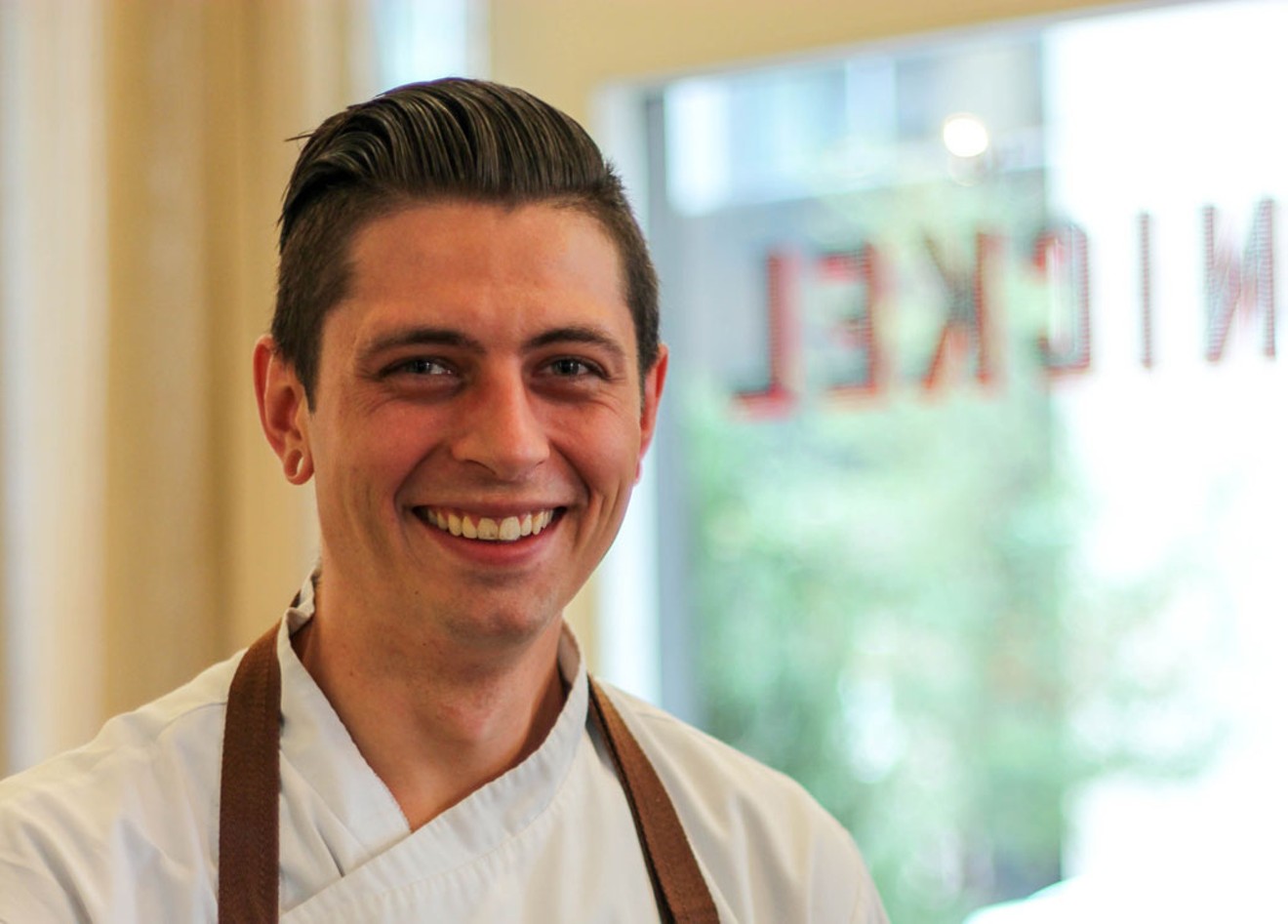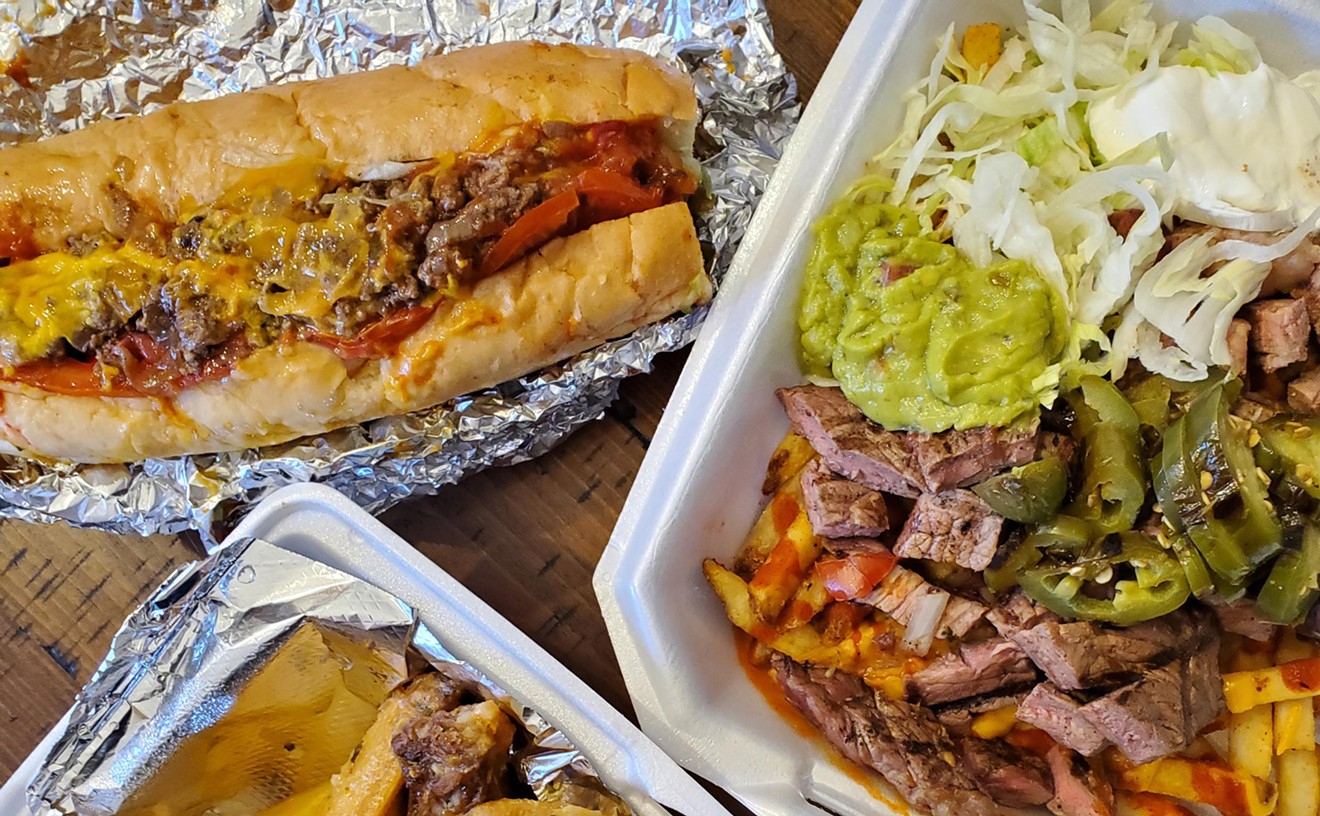After taking control of the kitchen at the Nickel on July 1, Russell Stippich rolled out his first menu at the start of the month, one that pays homage to American classics and draws inspiration from the culinary memories of his kitchen staff. Stippich learned to cook in some of the area’s most exalted restaurants, spending his formative years at Frasca before moving on to Acorn and the Squeaky Bean. He landed at the Nickel three years ago, where he drew from all the lessons he’d learned in earlier kitchens. In this interview, Stippich talks about the difference between American and New American cuisine, how hospitality impacts the back of the house, and the Mexican beer that’s always in his fridge.
Westword: You recently put out your first menu at the Nickel, and you said when it rolled out that it pays homage to your past experience. Tell us a bit about it.
Russell Stippich: The food is simple — not simple in actual execution or the amount of work that goes into the dish, but simple in the thought process behind it. I don’t want to make things that are going to make people ask a lot of questions. Dishes come from family gatherings and my kitchen’s childhood memories. Like the romaine: It’s a Waldorf salad, but we played around with it to make it our own. Hopefully, it will look familiar to the people who have had a Waldorf salad, but when they get it, it’s like, oh, yeah, the romaine is grilled. Or the beet salad. You’ll find beet and goat cheese on almost every menu in Denver, but we tried to find a new way to do it. It’s beet and goat cheese with tarragon purée, caramelized cocoa nibs and Colorado cherries. This is a dish I had been working on with Samuel McCandless at the Squeaky Bean. When I sat down to write the menu, I asked him if I could have that one. I can’t take credit; it’s Samuel’s dish. It’s always weird to borrow a dish from a chef, but we all work together.
That’s how we wrote this first menu. I had just taken over, and I huddled up the crew — sous-chefs and line cooks, the guys who wash dishes — and we talked about what we should do. We talked about dishes we had growing up, and if we could figure out how to do them. That’s how we got the halibut: I told the sous-chefs if they didn’t come up with a cool fish dish by the day the menu went out, they were doing salmon all summer. The halibut is what they came up with. We’re keeping the identity of Americana. There are a lot of things on the menu that you’ve heard of or had if you grew up in the United States, and your grandma might make it better than we do. We take ourselves seriously and want the food to be nice, look good and taste good, but we have a lot of fun. I enjoy cooking, and I want the guys who are working with me to enjoy cooking.
Let’s talk about the idea of Americana for a moment — I noticed you didn’t say “contemporary American” or “New American.” What is American cuisine, exactly?
To say you’re contemporary American as a restaurant is an easy way to do whatever you want, and there’s nothing wrong with that. We’re an American restaurant, but we try not to let it be an excuse to do whatever we want. You’d normally put a dish together by finding ingredients you’re excited about and build a dish around them. We’re reverse-engineering. For instance, we’re taking a classic steakhouse dish like creamed spinach and saying, okay, how do we break this down? How should we do the spinach? What kind of cream do we use? Dishes start with a story or a memory or a tradition with someone’s family, and we work our way backwards and then worry about how we’re going to find ingredients. Then there are dishes like our succotash: Succotash is Southern, but we do ours with Mexican-style street corn. We hit a couple of different slices of Americana.
You came up in some of this region’s best kitchens. Tell us a little about your background and the lessons you learned on your way to taking over the Nickel.
I started in restaurants as a server in a little vegetarian restaurant in Laramie, Wyoming. They opened a bar next door and asked if I wanted to go open it, so I started to learn to bartend. While doing the little bit of prep I had to do, I was hanging out with the guys in the kitchen, and I realized those guys had way more fun. I decided to move to Boulder, where I worked at Leaf for about a year and then went to the Greenbriar. I met Samuel McCandless there; he was leaving to go back to Frasca as sous-chef, and he took me along for the ride. I was there for two and a half, three years, and I worked my way through the kitchen, trying to learn as much as I could. I learned how to cook there, and I also learned how to carry yourself. As in every kitchen, we were all hooligans at heart. But I really learned how to treat people with respect. After that, I wanted to do something different, and Steve [Redzikowski] was opening Acorn, so I moved here to do that. Frasca is busy, but Acorn can be insane. I hadn’t cooked for that many people that quickly before. I learned how to grind food out of a kitchen. It was the best of both worlds. Steve was able to take the flavors and techniques and care you get at a restaurant that does forty or fifty covers, and he found a really great way to do that for a ton of people. I learned not to be so serious from Steve. These are our jobs, but we should have fun doing them; it’s cooking and hanging out. I met Theo Adley when I was working at Frasca, when he was still running the Pinyon. When he went to the Squeaky Bean, Samuel left Frasca to join him, and they called and said, ‘Let’s get the band get back together.’ I was there for eighteen months, and that’s where I started to figure out who I was as a chef. It was a bunch of chefs I had worked with in the past. There were no line cooks in that kitchen, just four chefs hanging out five days a week, so it was a little no-holds-barred for a while. When Theo was running the Squeaky Bean, he really gave me that freedom to play around and figure out what I wanted to do with food. Then I got the phone call to come over here. I’ve gotten to work with a lot of chefs, and I took what I could from each and mashed it into who I am. I’m still figuring that one out, though — I’m only 29.
It seems you’ve made many of your career moves for the people you could work with rather than the restaurants themselves. Now your kitchen is filled with people you’ve worked with before coming to the Nickel. Does that extended collaboration enable creativity for you?
You form this bond with people when you work as many hours together as we did for as long as we did. Samuel [who now cooks at the Nickel] is a big mentor to me. My sous-chef here is Zach Patz, who was at Frasca and Pizzeria Locale the same time as Samuel and me. As was one of the pastry team — Zach Meier. It’s been six years now. and a lot of things have changed for all of us. We’ve all had a bunch of different experiences. We’ve all worked with each other before, so we know each other’s habits and tendencies and recipes. I can say, “Remember that tarragon purée?” — and it’s done. It’s nice to have that camaraderie and relationship built in. And it goes beyond food or working together. We’re friends with each other outside of the kitchen; Samuel was at my wedding. We built a great dynamic in our kitchen. It’s fun to go out with a group of guys at the end of the night. And if something comes up, there’s never resentment. The first response is, are they okay?
You’ve worked in a lot of restaurants with strong front-of-house staffs, and now you’re at a hotel. How has that focus on hospitality impacted your outlook in the kitchen?
I learned that food is much more than being a good cook. I’ll crib a line from Bobby Stuckey: Service is what you do to someone, hospitality is how you make them feel. That’s really how Frasca was. There are so many examples of that. We had this table that was going to be late because their flight was delayed. It was 10 p.m., we were ready to close, and Bobby Stuckey came back and said, “They’ll be here in thirty minutes, and we’re going to stay open and give them the same experience. It’s not their fault that their flight was delayed, but it’s our fault if we don’t give them the same experience they would have gotten if they’d been here at eight.” You might have gone in there thirteen years ago to celebrate your first wedding anniversary; if you go back now, they’re going to remember your name and what wines you had and that you were going on your honeymoon in Bali. We’re fortunate to share those moments with people. People who work in hospitality get invited to everyone’s events; you don’t call your accountant to see if they want to sit down for your 25th wedding anniversary. People work hard and decide to come share a meal with you. It’s not just a big event for them; it should be for you, too. You can take a special event and make it memorable or take a bad day and make it better. Strive for it here. Bryan Dayton [at Acorn] is the same way.
What do you cook at home?
I don’t — my wife cooks at home. I have a wonderful wife who works for a nonprofit library. She’ll cook dinner at 10:30 or 11 so we can have dinner together. If I do cook at home, it’s peanut butter sandwiches.
What’s your go-to late-night snack?
There’s always some form of burrito happening here at 10 p.m. Tortillas are readily available, and we have a bunch of random stuff. Teres major, french fries, fancy sauce, avocado. The amount of nutrients in those things is pretty low. It’s not what I should eat at 10 p.m.
What’s always in your fridge or pantry?
Ramen. Curry paste, green or red. There’s usually some of the leftover pastries from here; all of our pastries here go away at the end of the night. And Tecate.
The Nickel is located at 1100 14th Street. It's open from 6:30 a.m. to 10 p.m. Sunday through Thursday, 6:20 a.m. to 11 p.m. Friday and Saturday. Find out more at 720-889-2128 or thenickeldenver.com.
[
{
"name": "Air - MediumRectangle - Inline Content - Mobile Display Size",
"component": "12017618",
"insertPoint": "2",
"requiredCountToDisplay": "2"
},{
"name": "Editor Picks",
"component": "17242653",
"insertPoint": "4",
"requiredCountToDisplay": "1"
},{
"name": "Inline Links",
"component": "18838239",
"insertPoint": "8th",
"startingPoint": 8,
"requiredCountToDisplay": "7",
"maxInsertions": 25
},{
"name": "Air - MediumRectangle - Combo - Inline Content",
"component": "17261320",
"insertPoint": "8th",
"startingPoint": 8,
"requiredCountToDisplay": "7",
"maxInsertions": 25
},{
"name": "Inline Links",
"component": "18838239",
"insertPoint": "8th",
"startingPoint": 12,
"requiredCountToDisplay": "11",
"maxInsertions": 25
},{
"name": "Air - Leaderboard Tower - Combo - Inline Content",
"component": "17261321",
"insertPoint": "8th",
"startingPoint": 12,
"requiredCountToDisplay": "11",
"maxInsertions": 25
}
]













